On this page
Immunisation data is collected from Aotearoa Immunisation Register (AIR) and is collated weekly.
We report both publicly funded and some privately funded flu vaccines that are recorded. Not all the privately funded vaccines are recorded in our registries which means the total number of vaccines administered will be higher than reported. Influenza vaccines are funded under several criteria. Further details is on our Health Information and Services website. Our reporting is focussed on the 2025 funded age group.
Total vaccinations
|
Māori |
Pacific people |
Asian |
Other |
Total |
|
|
Week: 28 September to 22 September |
210 | 236 | 590 | 801 | 1,837 |
|
Total vaccinations 65+ years (YTD) |
36,465 | 18,775 | 46,880 | 465,383 | 567,503 |
|
Total vaccinations (YTD) |
98,918 | 59,125 | 204,101 | 866,487 | 1,228,631 |
Definitions
- Ethnicity: This is based on prioritised ethnicity, which means each person is only counted against a single ethnicity category. When a person has multiple ethnicities recorded, then the prioritised ethnicity is ranked in the order of 1) Māori 2) Pacific Peoples 3) Asian 4) Other. For example, if a person is recorded as their ethnicities being both Māori and Pacific Peoples, their prioritised ethnicity will be Māori, i.e. they will not be counted in the Pacific Peoples group.
- YTD: is defined as vaccinations occurring from 1 March 2025 to 30 September 2025.
Vaccinations by district
Number of vaccines by district and prioritised ethnicity. Based on the district of where the person lives, which may differ from where the person received their vaccine.
|
District |
Maori |
Pacific |
Asian |
Other |
Total |
|
Auckland |
5,712 | 9,354 | 39,532 | 67,779 | 122,377 |
|
Bay of Plenty |
7,102 | 828 | 3,784 | 45,730 | 57,444 |
|
Canterbury |
8,473 | 3,048 | 20,083 | 138,349 | 169,953 |
|
Capital and Coast |
6,408 | 4,243 | 15,157 | 74,165 | 99,973 |
|
Counties Manukau |
9,342 | 22,832 | 39,339 | 46,041 | 117,554 |
|
Hawkes Bay |
5,552 | 1,154 | 2,387 | 32,210 | 41,303 |
|
Hutt Valley |
3,952 | 2,383 | 7,302 | 30,342 | 43,979 |
|
Lakes |
4,506 | 469 | 1,779 | 15,864 | 22,618 |
|
MidCentral |
3,957 | 828 | 3,637 | 35,310 | 43,732 |
|
Nelson Marlborough |
2,338 | 670 | 2,199 | 38,664 | 43,871 |
|
Northland |
7,787 | 561 | 1,895 | 28,785 | 39,028 |
|
South Canterbury |
665 | 152 | 938 | 14,967 | 16,722 |
|
Southern |
5,041 | 1,532 | 6,887 | 76,956 | 90,416 |
|
Tairawhiti |
3,440 | 461 | 529 | 5,558 | 9,988 |
|
Taranaki |
2,672 | 360 | 1,469 | 24,284 | 28,785 |
|
Waikato |
10,601 | 2,273 | 11,757 | 69,830 | 94,461 |
|
Wairarapa |
1,236 | 273 | 622 | 12,311 | 14,442 |
|
Waitemata |
7,102 | 7,300 | 43,806 | 89,571 | 147,779 |
|
West Coast |
565 | 80 | 335 | 6,739 | 7,719 |
|
Whanganui |
2,433 | 303 | 583 | 12,765 | 16,084 |
|
Total |
98,918 | 59,125 | 204,101 | 866,487 | 1,228,631 |
Vaccination uptake: age 65+ years
Uptake percent is calculated by comparing the flu doses to date for this year with the estimated number of people in New Zealand who are aged 65 and over.
The estimated population is sourced from AIR and validated against the National Health Index (NHI) and National Enrolment Service (NES) registers.
|
District |
Māori |
% |
Pacific |
% |
Asian |
% |
Other |
% |
Total |
% |
|
Auckland |
1,678 | 54% | 3,381 | 52% | 10,697 | 52% | 29,422 | 63% | 45,178 | 59% |
|
Bay of Plenty |
3,365 | 49% | 204 | 49% | 633 | 42% | 29,727 | 59% | 33,929 | 58% |
|
Canterbury |
2,575 | 60% | 661 | 50% | 3,266 | 51% | 69,507 | 69% | 76,009 | 67% |
|
Capital and Coast |
1,599 | 60% | 1,453 | 55% | 3,038 | 56% | 28,950 | 71% | 35,040 | 68% |
|
Counties Manukau |
3,213 | 54% | 7,532 | 52% | 11,513 | 53% | 26,015 | 60% | 48,273 | 56% |
|
Hawkes Bay |
2,225 | 50% | 263 | 51% | 360 | 45% | 19,979 | 64% | 22,827 | 62% |
|
Hutt Valley |
1,197 | 56% | 779 | 57% | 1,510 | 57% | 13,784 | 68% | 17,270 | 65% |
|
Lakes |
2,077 | 49% | 162 | 52% | 295 | 47% | 9,945 | 59% | 12,479 | 57% |
|
MidCentral |
1,556 | 49% | 249 | 47% | 777 | 53% | 21,203 | 63% | 23,785 | 61% |
|
Nelson Marlborough |
907 | 56% | 95 | 47% | 236 | 51% | 23,849 | 63% | 25,087 | 63% |
|
Northland |
3,642 | 45% | 218 | 47% | 317 | 47% | 19,986 | 54% | 24,163 | 52% |
|
South Canterbury |
256 | 57% | 22 | 39% | 78 | 45% | 9,332 | 65% | 9,688 | 65% |
|
Southern |
1,683 | 58% | 298 | 53% | 614 | 51% | 41,509 | 66% | 44,104 | 65% |
|
Tairawhiti |
1,486 | 49% | 55 | 51% | 37 | 37% | 3,560 | 59% | 5,138 | 56% |
|
Taranaki |
1,140 | 53% | 59 | 51% | 204 | 50% | 14,668 | 62% | 16,071 | 61% |
|
Waikato |
4,178 | 49% | 658 | 49% | 2,064 | 47% | 41,242 | 60% | 48,142 | 58% |
|
Wairarapa |
454 | 52% | 61 | 55% | 78 | 50% | 7,439 | 64% | 8,032 | 63% |
|
Waitemata |
2,298 | 53% | 2,518 | 51% | 10,820 | 50% | 46,858 | 59% | 62,494 | 57% |
|
West Coast |
235 | 54% | 20 | 62% | 31 | 51% | 4,217 | 55% | 4,503 | 55% |
|
Whanganui |
1,086 | 55% | 89 | 49% | 100 | 47% | 8,377 | 62% | 9,652 | 61% |
|
Total |
36,862 | 52% | 18,781 | 52% | 46,675 | 51% | 469,659 | 63% | 571,977 | 60% |
Vaccination uptake over time: age 65+ years
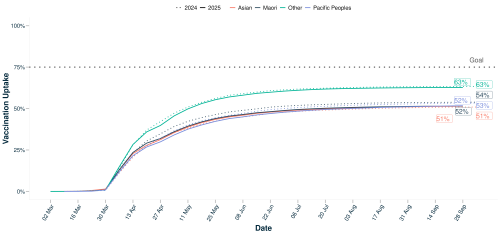
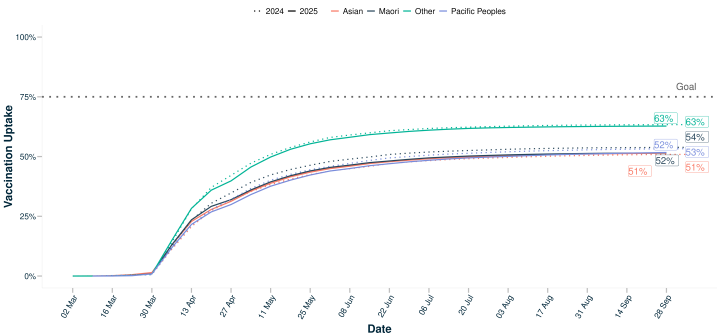
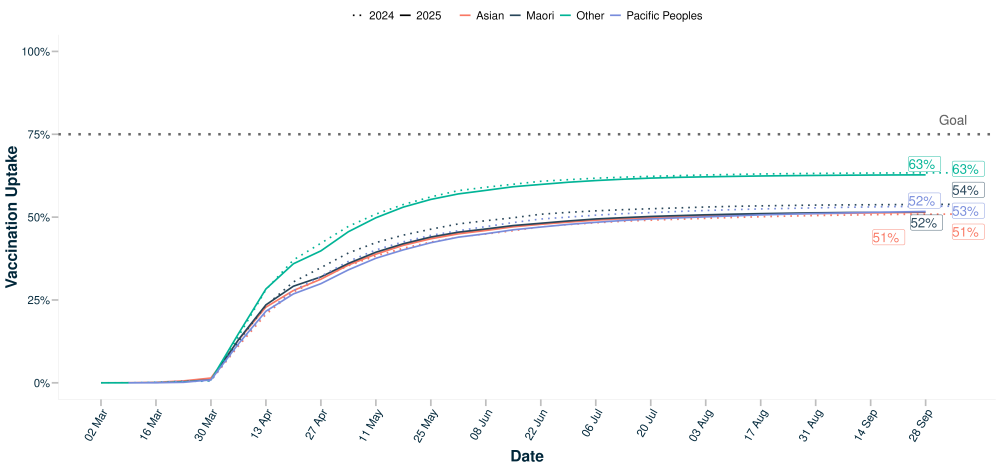
Vaccinations per week for all age groups
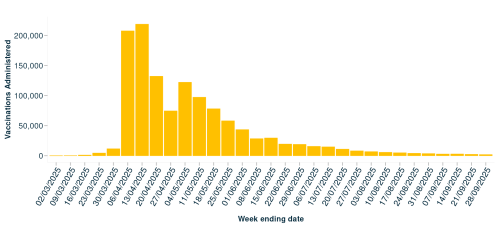
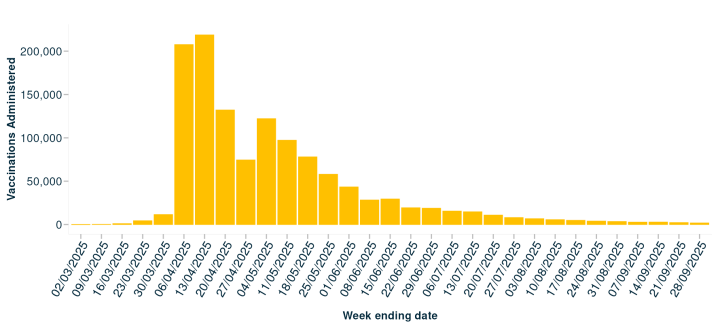
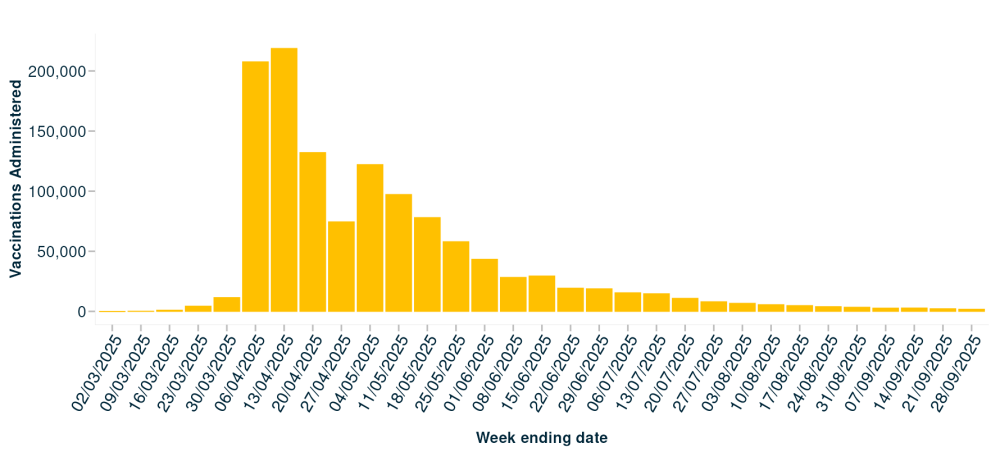
Notes on report data:
- Immunisation data is sourced from Aotearoa Immunisation Register (AIR) which includes migrated information from the COVID-19 Register (CIR) and National Immunisation Register (NIR) and collated weekly.
- As of 2025, a few changes have been introduced into how the numbers are calculated and displayed:
- Vaccination uptake calculation is based on a snapshot of the estimated eligible population in AIR as at 01 March of the current year. This snapshot does not take into account any deaths or births that occur during the influenza season, so that the uptake can be observed against a static population.
- Age group is determined by age as at 30 September of the current year to ensure uptake captures not only those who are eligible for funded vaccination at the start but also those who become eligible over the course of the season. This definition was updated on 28 August 2025; prior to this change, age was calculated at the start of the influenza season.
- Totals include those whose assigned domicile district is overseas or unknown, but the actual numbers of overseas or unknown district will not be displayed to protect data confidentiality.
- Data captured on paper or systems other than AIR are not included.
- The data contains public and privately funded influenza vaccinations. Following the 2021 influenza season we have seen a higher proportion of privately funded vaccines being recorded. This is due to additional immunisation registries and the ability of pharmacies and other providers being able record vaccinations. Data between years, therefore, are not directly comparable.
Related content
-
Influenza programme
Information about the influenza programme -
Influenza vaccine (goes to another website)
A yearly flu vaccine is recommended for everyone over 6 months old. It is free if you are aged 65 and over, if you are pregnant, and for lots of other people.